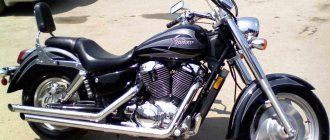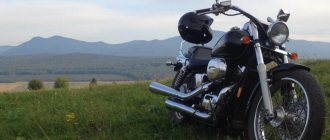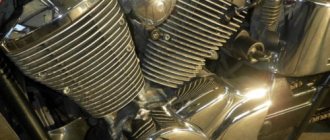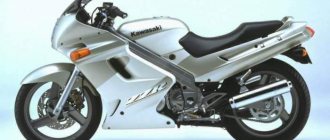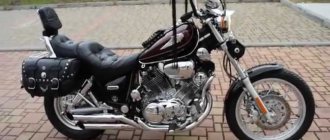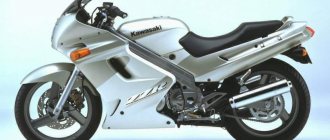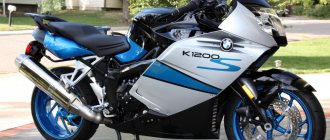Restyling
Two years later (in 1987) the bike was modified. This affected both the external appearance of the Honda Shadow 1100 and the technical component of the motorcycle. The model's wheelbase has grown. The mufflers, which were located on the sides, were moved to the right side of the motorcycle. At the same time, the power of the model was cut, now the engine produced only up to 67 horsepower. It should be noted that the engine's operating speeds have decreased, this has led to an increase in traction characteristics at the bottom and middle. The newfangled hydraulic clutch has given way to a standard cable version.
It was this modification in 1987 that marked the beginning of the road to legendary status that the Honda Shadow 1100 motorcycle eventually achieved. The first versions from 1985 and 1986 are extremely rare today and did not have good sales ratings in their time.
After 2003
Almost all of the modifications considered have become history over time. After 2003, the manufacturer produced only the basic modification VT1100C Spirit, as well as the VT1100C2 Saber. It must be said that both of these models reached 2007 without any major changes. These models were later discontinued. When this happened, she offered a successor in the form of the Honda VTX 1300. This was the end of the legendary era of the Honda Shadow of that design. Representatives of the company themselves said that they discontinued the model with great melancholy and sadness. But this is business, there is no time for sentimentality, it was necessary to impose a fight on competitors with a new, relevant model.
Modifications
It is a rare cruiser model that can boast such an abundance of modifications that have always found their fans.
It's time to arrange all the modifications in chronological order. But first, it is worth noting that some left the market in order to make way for a more modern modification, while others were simply discontinued due to obsolescence. Two lists below - year of birth, year of departure.
- 1983 - Honda NV750 Custom .
- 1986 - Honda Shadow 750 . Replacing the name, reworking both the filling and the appearance.
- 1997 - Honda Shadow 750 ACE (sold in America only) Shadow 400 is released for Japanese markets.
- 2000 - Birth of ACE Вeluxe , the filling of which repeats Gold Wihg of the same years.
- 2000 - Launch of Honda VT750DC Shadow Spirit . In Japan it goes by the name Slasher , in European markets - Black Widow .
- 2003 - Honda VT750C Aero .
- 2007 - Honda VT750C2 Shadow Spirit , an update to the previously released VT750C .
- 2009 - Honda VT750C2B Phantom (sometimes called Black Spirit), Aero in black packaging.
- 2010 - Honda Shadow RS .
The first couple of versions leave the market replacing each other.
- 1986 Honda NV750 Custom.
- 1997 - Honda Shadow 750.
Next, the intervals add up like this:
- 2003 - Honda Shadow 750 ACE , Aero becomes its successor.
- 2007 - Slasher , Japanese and versions of other countries, becomes history.
- 2013 - Honda Shadow RS .
- 2015 - completion of production of the Honda VT750C2 Shadow Spirit .
Of the total number of models on the assembly line, only Aero and Phantom . The release of both continues, taking into account new technological solutions and requirements.
Fuel consumption
Officially indicated in the papers, the fuel consumption from the manufacturer for the Honda VT1100 Shadow is 5.2 liters for every 100 km of distance traveled. In practice, it comes out to at least one liter more, and the exact fuel consumption value depends on your driving style and manner and the quality of the fuel.
But as a rule, fuel consumption on such motorcycles is close to the declared one. After all, such devices are bought for measured travel in harmony with oneself, and not for crazy races from traffic lights to the squeal of rubber skidding on the asphalt.
I decided to talk about the first steps in gaining experience driving a motorcycle and at the same time my impressions of my first iron horse based on the results of the first season... it might be interesting for those who are just at the beginning of their journey.
I previously wrote about how I spent a painfully long time trying to become a motorcyclist and finally bought my first motorcycle. here…
And now it’s the end of April 2021, the weather is full of sunshine and temperatures of +20 and above. There are already a lot of motorcycles on the street, but I still can’t start my first season. I have already gone and looked at my Phantom more than once from all sides, read the manual twice, but decided that I would open my season only after learning to ride. Main reasons 3: firstly, the last time I sat behind the wheel of a motorcycle was at the traffic police exam 1.5 years ago, and it was a 100 kg Ebrik, and I have a 250 kg Shadova; secondly, I didn’t want to drop/scratch/break my horse out of nowhere (and I’ve already seen quite a lot of similar videos), and go into debt to restore it, because even when I bought a motorcycle and equipment for it, I spent all my “reserves” funds")). And finally, third on the list, but perhaps first in importance, I didn’t want to lose a lot of time or even end the season ahead of time somewhere in the traumatology department, or even worse...
I turned to a friend of mine at the Motor School, planning to take a couple of lessons in driving a cruiser on my motorcycle, but the friend told me to first show what I could do on their Ebrik. And it turned out that I don’t know how to do ANYTHING... Yes, naturally, I can start, drive straight, change gears and turn passably, but about any counter-steering, leaning in corners, maneuvering at ultra-low speeds a la between rows and traffic jams, starting off into a turn, emergency braking, etc. I had no idea. So “a couple of lessons on my motorcycle” was out of the question. Even more so about traveling to a city with our heavy traffic (St. Petersburg) on a 250-kilogram carcass. In general, I realized that I would still have to get into debt, but in order to avoid even bigger troubles in the future.
To my great regret, I had to undergo training at that same Ebrik, because... For the reasons mentioned above, no one was going to give me even a training Dragstar, “I’m not ready!” (I mean). Only after completing the basic course.
But I was done with it pretty quickly, and I signed up for an advanced course. God! How difficult and clumsy the training Dredge seemed to me! 200 kg after Ebrik.
How will I ride with my 250 kg, and even with a passenger and cargo??? It was terribly scary to practice the already familiar tilts, high-speed turns, especially when driving with one hand, starting to turn and even a banal snake. But after some time I got used to it, without ever dropping it, which I was very afraid of. In addition to the weight, there was a very uncomfortable steering wheel, which was located low and rested on the thigh when cornering.
After Draghi I boarded the training Vulcan 800...
Here I first felt what it was like... not even driving... sailing on a cruiser. Huge, comfortable, with a fairly comfortable steering wheel, saddlebags and a windshield. And the gorgeous sound of the engine and exhaust... I liked it very much... in a straight line...
But the weight... I was just afraid to turn it. I turned with SUCH radii that I barely fit into the area! Due to the combination of a wide, high, seemingly comfortable steering wheel and a large mass, I could not get used to it, and every now and then it tried to throw me to the side. I was barely able to keep him from falling over a couple of times in slow turns when I took all his weight on my left leg. It was really hard. And I thought with horror how I would ride my Phantom, which is even heavier. I still don’t understand how people drive a 500-kilogram Golda or, for example, an Electric Train.
But in the meantime, the course was completed and, as a bonus, I was given a ride on a “sport”, in my opinion it was a CBR 600.
The dynamics after the “choppers” are of course amazing... rocket! Feels like completely different technologies! But acceleration is the only thing I liked... the landing position, the position of my hands on the steering wheel, the center of gravity... I was once again convinced that it was not for me. Not for the city, in any case, but I’d love to drive it on the track 
So... basic and advanced training is completed, and I was allowed to ride all the same exercises on my own horse! By that time, the arches and side cases had already been purchased and installed, so it was no longer so scary to drop them. And so I sit on my Phantom on the set. I used to sit on it in the garage, but now I have something to compare with after training. I immediately appreciated the seating position and the position of my hands on the steering wheel. Finally, the steering wheel is at the ideal height for me: in the middle between Draga and Vulcan. Moreover, it is straight, which is much more familiar and convenient for me after a bicycle.
The seating position is lower than that of the Vulcan, and it simply refuses to fall over on its side; the weight feels completely different. Holding it with one leg is much easier. But at the same time, with my height of 180 cm, it is comfortable to sit, my knees are located where they need to be, my feet rest comfortably on the footpegs, brake pedals and gear shift.
Finally I put it in first gear and start moving for the first time... OH DAMN! How much lighter it becomes when moving from the lowest speeds! It begins to drag from the very beginning of the movement, calmly, evenly and confidently. Despite the steering wheel being tighter than that of the choppers described above, when moving it turns almost effortlessly, holds its course perfectly, and is absolutely stable at ultra-low speeds. It is very easy to control between rows and is absolutely not annoying. Gears shift clearly, finding neutral does not cause problems, which I cannot say about Draga and Vulcan, although perhaps this is a problem specifically with “training” models. The dynamics are enough in urban conditions: about 6 seconds up to 80-100 km/h allows you to almost always start from a traffic light first and drive to the next intersection in splendid isolation :)) Despite the relatively small engine power, as further operation showed, there are enough horses , to carry my 100 kg, Two about 50 kg and 15 kilograms of cargo at a speed of 120 km/h, and if desired, up to 140. Then it’s already difficult. But at such a speed, the oncoming air flow puts a lot of pressure on your head, which of course will allow you to quickly strengthen/pump up your neck, but is not very comfortable when you are trying to enjoy the ride :)). Sometimes I catch myself thinking that I would like, of course, a little more power. I hope that installing a windshield will partially solve the problem, although I don’t strive to drive constantly above 120 km/h. I consider this speed to be optimal from the point of view of safety and contemplating the terrain/enjoying the road.
The exhaust sound is relatively quiet, smooth, and when Harleys pass nearby, you somewhat envy their louder “chop-chop-chop,” the standard among cruisers. But on long hauls your ears don’t get tired :)) In traffic jams there’s enough volume, in most cases they can hear you even as you’re approaching.
Brakes: many people write that the Shadovkas have clearly insufficient brakes and are extremely lacking in ABS. I can’t say anything about driving with ABS, I have no experience, but a braking distance of 4-5 meters from 60-70 km/h seems to me to be quite a decent result. In my life I never had to brake urgently, but on the court I always managed to stay within these limits. And the less electronics there are in technology, the more reliable it is! :))
All the described sensations did not change and were only confirmed during the subsequent first season.
I also liked the presence of a steering wheel lock with the main key (perhaps all modern motorcycles have this, I don’t know) and an immobilizer. Again, I don’t know, maybe they can be hacked relatively easily, but it seems to me that the likelihood of theft is still greatly reduced. And of course the cardan - for me this was one of the most important conditions. I think it’s unnecessary to talk about the appearance =) Although the taste and color.
Among the disadvantages of this motorcycle, at first it seemed to me that there was a paucity of data displayed on the dashboard: speed, clock, mileage (total and daily) and a low fuel level indicator - that’s all. I'm not talking about indicators for oil overheating and engine problems.
But I wanted at least more revolutions, the exact fuel level or the number of kilometers that can still be stretched on the existing balances, or at least a couple of options for signaling the level: like the first “Attention, it’s time to think about refueling” and the second “AAA!!! I'M ALMOST DRY!!! FUEL FUEL WHERE YOU WANT!!! But the sensor starts to burn at 3.5 liters of 14.5 tank volume, and does not change in any way until there is no fuel at all. And it’s one thing when you’re driving along the highway and you realize that with a consumption of 5 liters of 95 per 100 km, you still have a reserve of 50-60 kilometers, and you can somehow track this moment. But once I got stuck in a terrible traffic jam on Navy Day in Kronstadt, and it was so dense that it took me about 40 minutes to get out of the city in first gear (a friend of mine took more than two hours to get out in gearbox!). The fuel level light started to come on right at the very beginning. I understood that while I was “sneaking”, I was also eating gasoline, but I had no idea how much. In any case, I’ll drive 40 km to my favorite gas station in St. Petersburg, I thought. But after traveling less than 20 km, the motorcycle began to “sneeze” and quickly stalled - I didn’t even immediately understand what was wrong, I was afraid of problems with the engine. But I quickly came to the conclusion that the problem was most likely gasoline, and it was simply a miracle that I stood about 500 meters from the gas station that I had just passed. If there were any gradations in the signaling of this sensor, this situation could have been avoided by refueling in the city.
Over time, I got used to it and generally understood that apart from indicating the speed and mileage (and this is generally only needed sometimes), in general nothing is needed, but a more accurate indication of the fuel level is still missing for me.
There are no complaints about the controllability and the location of the controls, everything is very conveniently located, except that my thumb stubbornly did not get on the horn button, but by the end of the season I more or less got used to it.
Well, perhaps the main disadvantage of this motorcycle, but already for a Deuce, is the rear seat, which is very narrow in both width and height.
Its loin is not at all sweet in long-distance travel. If there are no complaints about my place, and yet stops are required at least once every 1.5-2 hours, then I can’t imagine how she sits through those same 1.5-2 hours. A 3-week trip around Europe is planned for the next season, and this clearly needs to be resolved somehow. It is not yet possible to change the standard seat to another one. Can anyone give me some advice? For now we are leaning towards buying and attaching some small pillow.
In summary... as they say on many forums, the Honda Shadow 750 is a great motorcycle for beginners. Excellent handling, excellent traction, legendary Honda reliability, a comfortable fit for a tall person and the beautiful appearance of a classic cruiser. And Shadow Phantom remains completely true to these traditions.
PS Finally, I would like to say that I highly recommend that all novice motorcyclists spare no expense and still undergo pre-training at the Motor School, because... 250 kg is still not a training EBR, and not even most motorcycles. And in general, the skills give you very useful ones, which you then use every day.
Wishing everyone a speedy opening of the season and smooth roads! =)
Honda Shadow 1100: reviews
Let's start right away with the question of fuel. You shouldn’t skimp on it when the conversation turns to this motorcycle. Up to a certain point, the bike will absorb low-grade fuel without problems, but then big problems will occur with the fuel system, which will result in large financial expenses. It is for this reason that reviews recommend avoiding such troubles by refueling at decent gas stations.
Also, the owners of this motorcycle say that it loves to be maintained. If you service your bike in a timely manner with high-quality components and consumables, then there should not be any problems with the motorcycle.
Honda shadow 400. Review
This motorcycle belongs to the cruiser class, which naturally means traveling long distances on roads with good surfaces. Its appearance is in many ways reminiscent of the then iconic Harley-Davidson. The Honda shadow 400 was produced exclusively for Japan and was not officially exported to other countries, but, like many other models of this volume, it unofficially entered the markets of many countries, which could not but please lovers of a comfortable ride.
We also recommend that you read the review of the Honda Steed 400 motorcycle, the technical characteristics of which are almost identical to the Shadow.
The peculiarity of the Honda shadow 400 is that the external dimensions and appearance exactly match those of 750 cm3 motorcycles, which allows the use of many high-end decorative parts. Full-size equipment makes it possible to feel more confident on the road.
Fit and comfort
We must pay tribute to the creators of the model. This bike is pleasant and comfortable to sit on. After long trips nothing hurts or becomes numb. Even tall and very heavy people can find a comfortable position. The long wheelbase of the bike does its job. It should be noted that the passenger seat is also very comfortable to sit here. It’s a pleasure to travel on such a motorcycle, including long distances.
A cruiser is supposed to be comfortable, but this model is as comfortable as the sofa in your living room. Add to all this the smoothness and softness of the ride, as well as the pleasant rumbling of the engine - and you get an ideal option for long-distance travel for your pleasure.
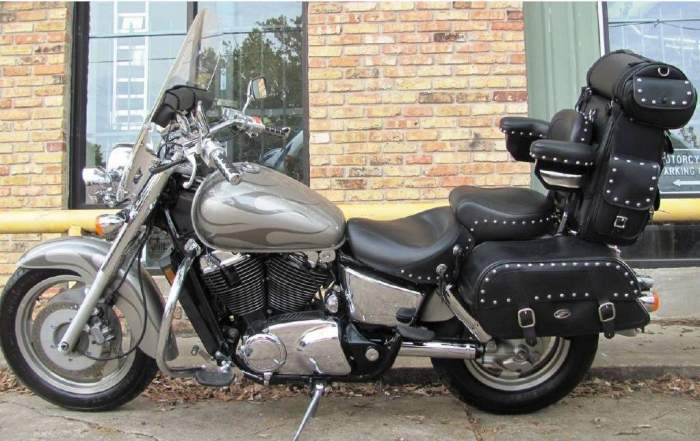
Prices
The price for this motorcycle in decent good condition and without mileage in Russia starts at three and a half thousand dollars. If we talk about options in our market, then here you can find an option from one hundred and sixty thousand rubles.
And in our country you can find a good well-maintained bike, and abroad you can run into a “killed” version. As a rule, versions without mileage in Russia have the best technical condition, but there is always an exception to the rule. Before purchasing, carefully check the technical condition of the copy so that you do not later invest serious money in correcting problems caused by the previous owner.
As for the prices for spare parts, everything is approximately predictable. Not too cheap, but not prohibitively expensive either. Some kind of “golden mean”. But we must pay tribute to the original spare parts. They are very high quality and last a long time.
What defines a cruiser?
So I’m attached to this word, right?) And this is because even when I bought it, I already had almost the entire kit installed to complete such a motorcycle specifically for a long trip on the highway.
- platforms instead of footrests
- high and wide windshield
- gel seat for big American butt
- 2 capacious side bags with locks (locks on chopper-shaped bags are generally a rare thing)
The only things missing were roll bars and an adequate exhaust. However, I'm working on it 
Speaking of bags. I have quick-release side bags, but even without them I still have a rear “suitcase” of 30 liters in volume. This means that I can easily carry with me a repair kit for wheels, a cover, a chain, a backpack with things, and all this can easily fit into just 1 bag. Nice? Of course, however, for a trip (especially if it is with tents) you will have to greatly moderate your appetites, and the ability to carry a bunch of things with you is somewhat...
corrupts
relaxes. But in general, yes, the chances that a motorcycle with bags that appears on the horizon will have the harness you need so much right now are much higher than that of the same sportbike.
What happens if you remove all this body kit? It will seem to be a cruiser, but not quite - not the canonical “chopper”, but also not a cruiser ready for “cruising”. In a word, it will not be much different in appearance from some HD 883. What then is the point of a larger cubic capacity in this case? Well, first of all, acceleration. Oddly enough, even owners of “quiet” bikes sometimes change their car to a “faster” one. The second, and no less important point is the roar of the engine. It is not for nothing that the owners of such equipment pay a lot of attention to the sound of the muffler and the muffler as a whole. And nothing adds “impressiveness” like a poorly suppressed muffler on a large cubic capacity 
By the way, to the question of why calling such a motorcycle a chopper is wrong.
Chopper is a style of motorcycle.
The word “chopper” (English chopper - from the English “chop” - to chop) is firmly attached to the type of motorcycle with an elongated frame and front fork. Motorcycles with a standard frame and fork are usually called stock. The predecessors of choppers were serial motorcycles that were converted for street racing - “bobbers” (English bob - short haircut). Unlike bobbers, the future chopper not only has all unnecessary things removed - the front fender, sometimes the front brake, a deep rear fender, but the frame itself is also seriously redesigned. A high handlebar is installed, often quite shocking (for example, “Ape Hangers”), a backrest (“Sissy bar”), the roots of which come from the same bobbers, and forward footrests for the motorcyclist. Typical attributes of many neo-choppers are also a rear “roller” (a wide wheel, sometimes called VShK - Great Wide Wheel in Russia), a dry (hardtail) frame (without rear suspension), a gas tank in the form of a small drop, a faceted diamond tank or “coffin” "(coffin tank) and a constant abundance of chrome parts.
That is, the key features of the “canonical” chopper are a minimal body kit, a forward fork and a redesigned frame. For example, like this =)
Honda Shadow 1100: technical specifications
It all depends on the specific modification. The characteristics of the Honda Shadow 1100 vary slightly depending on the version of the bike. But something can still be called something average. The weight of the motorcycle ranged from 245 kilos for the VT1100C version (years of production: 1985-1986) and up to 284 kilos (VT1100T version).
The VT1100C motorcycle (1987-1996 production) had the smallest tank; the volume was exactly thirteen liters. The largest fuel tank with a volume of almost sixteen liters had the versions of the last model years. The maximum speed of all models was 172 km/h, and acceleration to the first hundred was an average of six seconds.
The manufacturer chose a cardan as a drive; throughout the history of the model, a four-speed manual transmission and a five-speed manual transmission were offered in later versions. Cooling was always liquid, on all versions and modifications.
Motors were offered with two cylinders (four-stroke, V-shaped) from 53 “horses” to 78 horsepower in the very first motorcycle model series. The working volume of the power plant is 1099 cubic meters. The frame was made of high quality steel.
The front suspension was a telescopic fork with a travel of fifteen centimeters. The rear suspension was pendulum with a pair of shock absorbers (preload was adjustable), the suspension travel was ten centimeters. Thanks to the long wheelbase, the bike was very pleasant, smooth and soft to ride.
Honda shadow 400 reviews and realities
Owners of this equipment note the high reliability of the Honda shadow 400 motorcycle. The manual contains all the necessary information about caring for the bike. Nothing really breaks with him, and if you pass on time, then... and keep an eye on the oil - it will work forever. To calm down, you can grab a screwdriver and a set of sockets with a wrench from the tools, which can be hidden in the glove compartment under the seat. It is also advisable to take chain lubrication spray with you on long trips. Whatever model you like, Honda shadow slasher 400, ace, classic or any other, know: this is an excellent, reliable piece of equipment that brings a minimum of hassle during maintenance and maximum joy during operation.
Specifications
| Maximum engine power: | 33 HP |
| Torque: | 34 Nm |
| Working volume: | 398 cm3 |
| Motor type (cylinder arrangement, number of strokes): | V - shaped |
| Number of cylinders: | 2 |
| Number of valves: | |
| Intake type (Injector / Carburetor): | |
| Bore and stroke: | |
| Starting system (Electric starter, kick starter): | |
| Cooling system: | Air |
| Transmission (gearbox): | 5 |
| Clutch (Dry / Wet): | |
| Chassis | |
| Suspension (front/rear travel): | |
| Brakes (Front/Rear): | |
| Wheels / Tires / Rubber: | |
| Dimensions and weight | |
| Dimensions (Length / Width): | |
| Seat height: | |
| Ground clearance: | |
| Curb weight: | |
| Weight: | 225 kg |
| Fuel tank capacity: | 14 l. |
| Battery capacity: | |
| Year of release: | |
| Country of Origin: |
Model competitors
This Japanese cruiser had two main competitors in its class. This includes the Japanese Yamaha XV 1100 Virago (Yamaha XVS 1100 Drag Star) and the Japanese Kawasaki VN1500 (Vulcan 88, VN-15). The fight was purely Japanese. But it was the Honda that became the main “samurai” in the class, although the struggle for leadership sometimes became serious, if you rely on the sales ratings of these motorcycles in different years of production. There were other competitors, but we named the main ones that made the manufacturer of this motorcycle nervous and worried about leadership in its class.
Bottom line
The Honda Shadow 1100 motorcycle is a worthy representative of its class. It can easily be classified as a legend, and random motorcycles do not fall into such a list. The appearance of the bike is very calm and classic (for its class), all characteristics are balanced and sufficient. Add here Japanese reliability and the relatively low cost of the model on the secondary market, and you get a very, very worthy option for cruiser lovers. On such a motorcycle you can travel around the entire planet, or you can just ride in your own city and beyond on weekends.
The motorcycle is loved and respected by bikers all over the world. This is a classic that is timeless. A simple hard worker in a stylish look. He will never let you down and will always deliver to your destination. This is a model of those years when motorcycles were alive, and not stuffed with various modern electronics and a variety of computer systems. This bike can be repaired in a garage environment on your lap. A model for those who appreciate the old school. A worthy copy for the garage of the owner who understands real motorcycles.
There is an opinion among motorcycle enthusiasts that one needs to grow into such a motorcycle from the point of view of motorcycle “philosophy”. There is some truth in this phrase, because a cruiser is almost never chosen as the first motorcycle, but very often experienced motorcyclists choose cruisers and never change class.
Honda Shadow 1100: photo, review, characteristics, reviews on News4Auto.ru.
Our life consists of everyday little things that in one way or another affect our well-being, mood and productivity. I didn’t get enough sleep - my head hurts; I drank coffee to improve the situation and cheer myself up - I became irritable. I really want to foresee everything, but I just can’t. Moreover, everyone around, as usual, gives advice: gluten in bread - don’t go near it, it will kill you; A chocolate bar in your pocket is a direct path to tooth loss. We collect the most popular questions about health, nutrition, diseases and give answers to them that will allow you to better understand what is good for your health.
V-Twin?
In case you don't know what a V-Twin is, I have a simplified gif of it. I actually have a lot of such schemes , but I’ll save them for the group.
I actually have a lot of such schemes , but I’ll save them for the group.
And there's a catch with the V-Twin. Actually, I can roughly divide two-cylinder V-shaped engines into 3 humorous types:
- true believers
- unfaithful
- household
The true believers are Harley & Davidson Co. Every Harley owner will tell you this. Just kidding, not everyone. It’s worth distinguishing between Harley owners and Harley riders, and in general, we don’t give in to stereotypes, it makes our brains sour. But, one way or another, I called the Harlev version of the V-Twin “correct” - shaking and vibrating.
But excuse me, what if I like the image of such motorcycles, but don’t like sitting on a vibrator? The cunning Japanese took it and built such a unit. Moreover, there are countless modifications to the line. Judge for yourself: Shadow ACE; Shadow ACE Tourer; Shadow Saber; Shadow Spirit; Shadow Phantom; Shadow Slasher; just Shadow; Black Widow; Steed finally - and even then I might not remember everyone. Actually, not only Shadow and not only Honda - there are a lot of models. But we're talking mostly about mine.
By the way, Steed 400 and 600 and Shadow 400 and 600 are generally slightly different - and this happened because Steed was sealed for the domestic market, and Shadovka for the external market. And there is only one motorcycle.
Depending on the modification, the Shadovka may be more or less similar in engine to a Harley (read - more or less shaking, with maximum torque at higher or lower speeds). But it’s just similar - water cooling is a useful thing. Especially in a city like Moscow. And if only there was water cooling! The Japanese decided not to worry - there was plenty of time and stuck... a driveshaft in my back door, just look:
The cunning Japanese have done a lot of other things. Previously, rebels did hard tails - this is when there is simply no rear pendulum and shock absorber. Then, when they got their butts back, they started installing a soft tail - this is when the frame is welded so that it looks like there is a hard tail, and the shock absorber is hidden inside the frame, under the seat. And if this is still the case in Steed (by the way, it is much closer to a chopper than the others), then in Shadow they simply didn’t bother and installed 2 shock absorbers on the outside.
And with the Saber they went even further - somehow it was accepted that the air filter on the V-Twin was on the side. But the Japanese took the Shadow Saber and put it in the free space under the seat. Compare:
On the one hand, it seems wrong again. On the other hand, it’s more convenient.
And, well, household ones - in general, a V-shaped 2-cylinder engine does not have to be a low-speed engine. Such engines have easily taken root in the Afica Twin and Transalp and in the same Suzuki V-storm. And not only there, but we are not talking about them.
Okay, my first question to myself was scattered to smithereens, and we went to compare everything and everyone!
